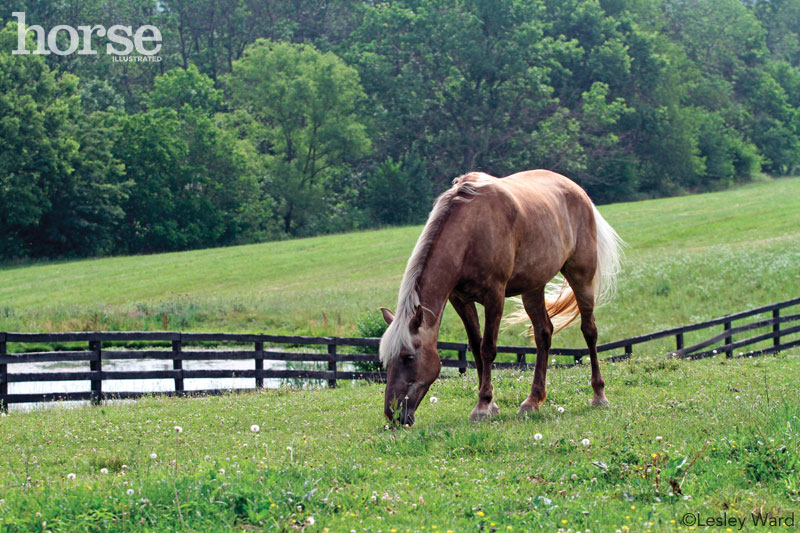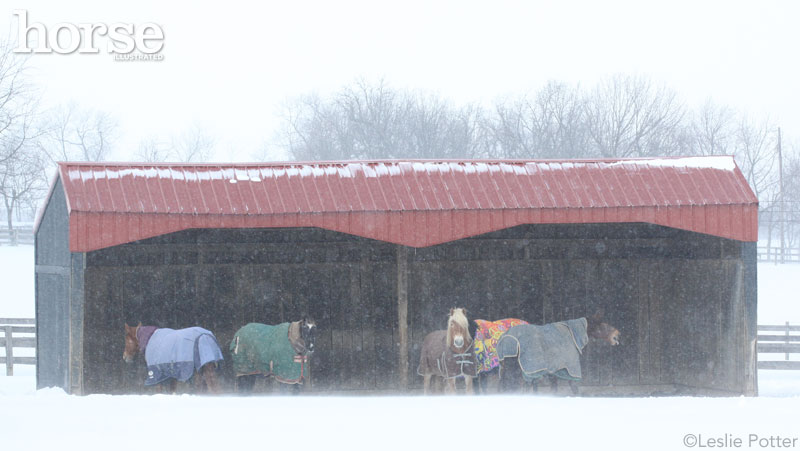
But it’s not just as easy as simply turning them out to fend for themselves. Pasture-kept horses (specifically those that don’t spend part of their day in a stall) have some important needs to consider.
Nutrition
In most parts of the country, pastures contain grass for grazing. However, this requires not having too many horses per acre, otherwise horses will eat and/or trample the grass until not much but dirt and weeds are left. In those cases, horses should be fed quality round bales or sufficient hay to meet their forage needs.
If the pasture does support sufficient grass growth, most people stop feeding hay from spring through fall. The main downside here is that some horses gain too much weight on unlimited 24/7 grazing, particularly if they aren’t ridden regularly or at all.
If your horse blimps up when turned out on good grass, he will need to wear a grazing muzzle or be moved to a dry lot to prevent weight-related problems, such as insulin resistance and founder.
Talk to your local agricultural extension agent about poisonous weeds that are common in your area and seeding/fertilizing regimens that would benefit your pasture grass. Keep pastures mowed regularly as a further method of weed control.
Exercise
Pasture living is an excellent form of exercise. A 2013 study at Virginia Intermont College found that pastured horses receiving no forced exercise had a similar fitness level to horses that were stall-kept and exercised frequently. Horses tend to roam many miles a day when kept in large pastures.
This doesn’t mean that your pasture horse won’t benefit from a good riding program. If you compete in a particular discipline, giving your horse a good workout at least three to four days a week will help keep obesity at bay and develop the muscles and training needed for your specific sport.
If your horse is retired due to soundness problems or arthritis, talk to your vet about whether he would benefit from full-time pasture living. The constant movement of pasture life is excellent for keeping joints lubricated and feeling their best. However, avoid mixing frail horses or slower seniors with young, rambunctious horses that may play too rough.
Herd Dynamics
Herd dynamics are an important part of any pasture situation. If there’s that one horse that just seems to bully yours, the stress and possible injuries could outweigh the benefits. Most boarding barns carefully select turnout buddies to achieve the perfect balance of personalities in a field. Like often goes with like: Usually mares are kept apart from geldings, and age, energy level and social personality should be considered too.

Shelter
Horses that never come inside must have some sort of shelter. A thick stand of trees will do, but ideally a run-in shed with at least a 12’x12’ footprint of space per every two horses is required. A smaller shed will mean the dominant horses keep the others out. Facing shelters so they open to the south and back up against cold north winds in the winter is usually recommended; if storms often come from the west in your area, you may want them to open to the southeast and have the blocking wall face northwest.
If you have milder winters and scorching hot summers, make sure to have plenty of overhang for shade. Summer is often a horse’s favorite time to use the run-in shed for a shady, fly-free hangout.
Fencing
One of the most critical things to think about for pastured horses is safe fencing. Never turn a horse out in a barbed wire pasture. This type of fence was designed for cattle with their tough hides, and one look at a barbed wire injury to a horse should be enough to steer you away from taking any chances. Similarly, large-square field wire is the perfect size for a horse to get a foot through and is best avoided. If you need a temporary fix to make these fences safe while you plan and budget for better fencing, simply buy some step-in posts and electric tape to make an economical inner fenceline.
Horse fencing varies widely in terms of price and owner preference. Wood-plank fences evoke images of the classic, picturesque farms every horseperson dreams about, but the reality is that boards rot and rusty nails get lose, so you must be willing to put constant maintenance into these fences for safety.
A great alternative is to use wood posts and top rails combined with small-square or diamond woven wire that is too small for horses to get a hoof through. This type of fencing is suitable for foals and keeping out wildlife as well. Painting is less intensive than a three- or four-board wood fence.
“Wood-look” flexible plastic boards or plastic-coated triple wire are a lower-maintenance option offering that pastoral look without the nails and splinters. However, these can be more expensive.
Highly visible electric tape or rope is a good budget-conscious alternative, although many do not recommend it for stallions or perimeter fencing. If dividing fields or making an inner fence, this is an excellent option. Always cap T-posts with tight-fitting plastic caps to protect curious equines from sharp metal edges.
Water
Water is the most important nutrient your horse consumes every day, and dehydration can lead to colic. Always make sure to check water troughs at least once a day. Ice can quickly make a trough undrinkable in winter, and heat/algae/increased drinking in summer can all lead to empty or unappetizing troughs. When possible, use a heated automatic waterer or floating heater designed for large troughs in winter, or be prepared to break up the ice multiple times a day. In the summer, move tanks to the shade where they will stay cooler and more appetizing.
Checking In
It’s easy to forget to keep tabs on every horse in a big herd, especially during grazing season when horses aren’t being fed hay. But it’s important to get an eye and hands on every horse every day, picking out feet and checking for cuts, swelling or puncture wounds so they can be detected and addressed early before they get infected.
Now that you are prepared for both the benefits and potential pitfalls of full-time pasture life, decide if it’s right for your horse. You may find you are rewarded with a horse that’s less stressed and more calm-minded.
A Field Guide to Grooming
A horse living outside in the full force of the elements will need more protection than a stalled horse. It’s best not to clip the insides of the ears for warmth in the winter and fly protection in the summer. Some people prefer to leave manes and chin whiskers long as well.
In most cases, your horse’s natural winter coat does a good job of keeping him warm, but you may need to add a waterproof sheet or turnout blanket in extra cold, wet or windy weather. Body clipping is best left for horses that can come into a stall when the weather turns nasty. If you do blanket, you will have to be vigilant about adding or removing them when big temperature swings hit during the day. If you start blanketing in late fall, your horse won’t grow as thick of a coat and will be dependent on blankets throughout the cold season.
In the summer, a fly mask may be helpful if you often notice lots of flies around your horse’s eyes. A fly sheet can keep sensitive horses bug-free and also prevent coat fading. Supplements containing ingredients that make horses less attractive to bugs are available, as well as those containing IGR, a substance that prevents flies from maturing in your horse’s manure piles. IGR supplements must be fed to all horses in the pasture for best results.
Horses with pink noses need additional care to prevent painful, blistering sunburns. Daily application of waterproof, high-SPF sunscreen is best but requires vigilant application (natural formulas are available if you are worried about using chemicals). Full-face fly masks also do an excellent job at shading the sun, but care should be taken to find a good fit that covers the nose completely and stays put when playing with pasture buddies.
HOLLY CACCAMISE is the managing editor of Horse Illustrated and a confirmed enthusiast of 24/7 pasture life for her horse whenever possible.
This article originally appeared in the September 2015 issue of Horse Illustrated magazine. Click here to subscribe!






great info
Good article. Great information.